Inhibition of LPS-Induced Inflammatory Response of Oral Mesenchymal Stem Cells in the Presence of Galectin-3
Abstract
1. Introduction
2. Materials and Methods
2.1. Ethic Statement
2.2. Cell Culture Establishment
2.3. Cellular Characterization
2.4. Experimental Study Design
- -
- hGMSCs alone, used as a negative control (CTRL);
- -
- hGMSCs cultured with GAL-3 0.25 µg/mL for 72 h;
- -
- hGMSCs cultured with GAL-3 0.25 µg/mL + GAL-3 Ab 2 µg/mL for 72 h;
- -
- hGMSCs cultured with GAL-3 0.25 µg/mL + GAL-3 BP 0,25 µg/mL for 72 h;
- -
- hGMSCs cultured with 5 μg/mL of LPS-PG for 72 h;
- -
- hGMSCs cultured with GAL-3 0.25 µg/mL + 5 μg/mL of LPS-PG for 72 h;
- -
- hGMSCs cultured with GAL-3 0.25 µg/mL + GAL-3 Ab 2 µg/mL and 5 μg/mL of LPS-PG for 72 h;
- -
- hGMSCs cultured with GAL-3 0.25 µg/mL + GAL-3 BP 0.25 µg/mL and 5 μg/mL of LPS-PG for 72 h.
2.5. Confocal Laser Scanning Microscope (CLSM) Analysis
2.6. Western Blot Analysis
2.7. Real-Time RT-PCR Analysis
2.8. Statistical Analysis
3. Results
3.1. Human GMSCs Exhibited the Stemness Markers Expression and the Osteogenic and Adipogenic Differentiation Capacity In Vitro
3.2. GAL-3 Inhibited the Inflammation Pathway in hGMSCs Stimulated with LPS-G
4. Discussion
5. Conclusions
Author Contributions
Funding
Institutional Review Board Statement
Informed Consent Statement
Data Availability Statement
Conflicts of Interest
Abbreviations
| LPS | lipopolysaccharide |
| TLR | Toll-like receptor |
| MSC | mesenchymal stromal/stem cell |
| hGMSC | human gingival MSC |
| IL | interleukin |
| IFN | interferon |
| PDLMSC | periodontal ligament stem cells |
References
- Andrzejewska, A.; Lukomska, B.; Janowski, M. Concise Review: Mesenchymal Stem Cells: From Roots to Boost. Stem Cells 2019, 37, 855–864. [Google Scholar] [CrossRef] [PubMed]
- Dominici, M.; Le Blanc, K.; Mueller, I.; Slaper-Cortenbach, I.; Marini, F.C.; Krause, D.S.; Deans, R.J.; Keating, A.; Prockop, D.J.; Horwitz, E.M. Minimal Criteria for Defining Multipotent Mesenchymal Stromal Cells. The International Society for Cellular Therapy Position Statement. Cytotherapy 2006, 8, 315–317. [Google Scholar] [CrossRef]
- Han, Y.; Yang, J.; Fang, J.; Zhou, Y.; Candi, E.; Wang, J.; Hua, D.; Shao, C.; Shi, Y. The Secretion Profile of Mesenchymal Stem Cells and Potential Applications in Treating Human Diseases. Signal Transduct. Target. Ther. 2022, 7, 92. [Google Scholar] [CrossRef] [PubMed]
- Viswanathan, S.; Shi, Y.; Galipeau, J.; Krampera, M.; Leblanc, K.; Martin, I.; Nolta, J.; Phinney, D.G.; Sensebe, L. Mesenchymal Stem versus Stromal Cells: International Society for Cell & Gene Therapy (ISCT®) Mesenchymal Stromal Cell Committee Position Statement on Nomenclature. Cytotherapy 2019, 21, 1019–1024. [Google Scholar] [CrossRef] [PubMed]
- Samsonraj, R.M.; Raghunath, M.; Nurcombe, V.; Hui, J.H.; van Wijnen, A.J.; Cool, S.M. Concise Review: Multifaceted Characterization of Human Mesenchymal Stem Cells for Use in Regenerative Medicine. Stem Cells Transl. Med. 2017, 6, 2173–2185. [Google Scholar] [CrossRef]
- Gronthos, S.; Zannettino, A.C.W.; Hay, S.J.; Shi, S.; Graves, S.E.; Kortesidis, A.; Simmons, P.J. Molecular and Cellular Characterisation of Highly Purified Stromal Stem Cells Derived from Human Bone Marrow. J. Cell Sci. 2003, 116, 1827–1835. [Google Scholar] [CrossRef]
- Zuk, P.A.; Zhu, M.; Ashjian, P.; De Ugarte, D.A.; Huang, J.I.; Mizuno, H.; Alfonso, Z.C.; Fraser, J.K.; Benhaim, P.; Hedrick, M.H. Human Adipose Tissue Is a Source of Multipotent Stem Cells. Mol. Biol. Cell 2002, 13, 4279–4295. [Google Scholar] [CrossRef]
- Selich, A.; Zimmermann, K.; Tenspolde, M.; Dittrich-Breiholz, O.; von Kaisenberg, C.; Schambach, A.; Rothe, M. Umbilical Cord as a Long-Term Source of Activatable Mesenchymal Stromal Cells for Immunomodulation. Stem Cell Res. Ther. 2019, 10, 285. [Google Scholar] [CrossRef]
- Patki, S.; Kadam, S.; Chandra, V.; Bhonde, R. Human Breast Milk Is a Rich Source of Multipotent Mesenchymal Stem Cells: Multipotent Breast Milk Stem Cells. Hum. Cell 2010, 23, 35–40. [Google Scholar] [CrossRef]
- Salingcarnboriboon, R.; Yoshitake, H.; Tsuji, K.; Obinata, M.; Amagasa, T.; Nifuji, A.; Noda, M. Establishment of Tendon-Derived Cell Lines Exhibiting Pluripotent Mesenchymal Stem Cell-like Property. Exp. Cell Res. 2003, 287, 289–300. [Google Scholar] [CrossRef]
- Pittenger, M.F.; Mackay, A.M.; Beck, S.C.; Jaiswal, R.K.; Douglas, R.; Mosca, J.D.; Moorman, M.A.; Simonetti, D.W.; Craig, S.; Marshak, D.R. Multilineage Potential of Adult Human Mesenchymal Stem Cells. Science 1999, 284, 143–147. [Google Scholar] [CrossRef]
- Paganelli, A.; Trubiani, O.; Diomede, F.; Pisciotta, A.; Paganelli, R. Immunomodulating Profile of Dental Mesenchymal Stromal Cells: A Comprehensive Overview. Front. Oral Health 2021, 2, 635055. [Google Scholar] [CrossRef]
- Fu, X.; Liu, G.; Halim, A.; Ju, Y.; Luo, Q.; Song, A.G. Mesenchymal Stem Cell Migration and Tissue Repair. Cells 2019, 8, E784. [Google Scholar] [CrossRef]
- Trubiani, O.; Pizzicannella, J.; Caputi, S.; Marchisio, M.; Mazzon, E.; Paganelli, R.; Paganelli, A.; Diomede, F. Periodontal Ligament Stem Cells: Current Knowledge and Future Perspectives. Stem Cells Dev. 2019, 28, 995–1003. [Google Scholar] [CrossRef]
- Yagi, H.; Soto-Gutierrez, A.; Parekkadan, B.; Kitagawa, Y.; Tompkins, R.G.; Kobayashi, N.; Yarmush, M.L. Mesenchymal Stem Cells: Mechanisms of Immunomodulation and Homing. Cell Transplant. 2010, 19, 667–679. [Google Scholar] [CrossRef]
- Wada, N.; Menicanin, D.; Shi, S.; Bartold, P.M.; Gronthos, S. Immunomodulatory Properties of Human Periodontal Ligament Stem Cells. J. Cell. Physiol. 2009, 219, 667–676. [Google Scholar] [CrossRef]
- Ding, G.; Liu, Y.; Wang, W.; Wei, F.; Liu, D.; Fan, Z.; An, Y.; Zhang, C.; Wang, S. Allogeneic Periodontal Ligament Stem Cell Therapy for Periodontitis in Swine. Stem Cells 2010, 28, 1829–1838. [Google Scholar] [CrossRef]
- Yu, Y.; Valderrama, A.V.; Han, Z.; Uzan, G.; Naserian, S.; Oberlin, E. Human Fetal Liver MSCs Are More Effective than Adult Bone Marrow MSCs for Their Immunosuppressive, Immunomodulatory, and Foxp3+ T Reg Induction Capacity. Stem Cell Res. Ther. 2021, 12, 138. [Google Scholar] [CrossRef]
- Xia, T.-T.; Hu, R.; Shao, C.-J.; Feng, Y.; Yang, X.-L.; Xie, Y.-P.; Shi, J.-X.; Li, J.-S.; Li, X.-M. Stanniocalcin-1 Secreted by Human Umbilical Mesenchymal Stem Cells Regulates Interleukin-10 Expression via the PI3K/AKT/MTOR Pathway in Alveolar Macrophages. Cytokine 2023, 162, 156114. [Google Scholar] [CrossRef]
- Liu, D.; Xu, J.; Liu, O.; Fan, Z.; Liu, Y.; Wang, F.; Ding, G.; Wei, F.; Zhang, C.; Wang, S. Mesenchymal Stem Cells Derived from Inflamed Periodontal Ligaments Exhibit Impaired Immunomodulation. J. Clin. Periodontol. 2012, 39, 1174–1182. [Google Scholar] [CrossRef]
- Castro-Manrreza, M.E.; Montesinos, J.J. Immunoregulation by Mesenchymal Stem Cells: Biological Aspects and Clinical Applications. J. Immunol. Res. 2015, 2015, 394917. [Google Scholar] [CrossRef] [PubMed]
- Cequier, A.; Vázquez, F.J.; Romero, A.; Vitoria, A.; Bernad, E.; García-Martínez, M.; Gascón, I.; Barrachina, L.; Rodellar, C. The Immunomodulation-Immunogenicity Balance of Equine Mesenchymal Stem Cells (MSCs) Is Differentially Affected by the Immune Cell Response Depending on Inflammatory Licensing and Major Histocompatibility Complex (MHC) Compatibility. Front. Vet. Sci. 2022, 9, 957153. [Google Scholar] [CrossRef] [PubMed]
- Yigitbilek, F.; Ozdogan, E.; Abrol, N.; Park, W.D.; Hansen, M.J.; Dasari, S.; Stegall, M.D.; Taner, T. Liver Mesenchymal Stem Cells Are Superior Inhibitors of NK Cell Functions through Differences in Their Secretome Compared to Other Mesenchymal Stem Cells. Front. Immunol. 2022, 13, 952262. [Google Scholar] [CrossRef] [PubMed]
- Zhou, Y.; Yamamoto, Y.; Xiao, Z.; Ochiya, T. The Immunomodulatory Functions of Mesenchymal Stromal/Stem Cells Mediated via Paracrine Activity. J. Clin. Med. 2019, 8, 1025. [Google Scholar] [CrossRef] [PubMed]
- Su, Y.; Xu, C.; Cheng, W.; Zhao, Y.; Sui, L.; Zhao, Y. Pretreated Mesenchymal Stem Cells and Their Secretome: Enhanced Immunotherapeutic Strategies. Int. J. Mol. Sci. 2023, 24, 1277. [Google Scholar] [CrossRef]
- Marconi, G.D.; Fonticoli, L.; Guarnieri, S.; Cavalcanti, M.F.X.B.; Franchi, S.; Gatta, V.; Trubiani, O.; Pizzicannella, J.; Diomede, F. Ascorbic Acid: A New Player of Epigenetic Regulation in LPS-Gingivalis Treated Human Periodontal Ligament Stem Cells. Oxid. Med. Cell. Longev. 2021, 2021, 6679708. [Google Scholar] [CrossRef]
- Pizzicannella, J.; Fonticoli, L.; Guarnieri, S.; Marconi, G.D.; Rajan, T.S.; Trubiani, O.; Diomede, F. Antioxidant Ascorbic Acid Modulates NLRP3 Inflammasome in LPS-G Treated Oral Stem Cells through NFκB/Caspase-1/IL-1β Pathway. Antioxidants 2021, 10, 797. [Google Scholar] [CrossRef]
- Diomede, F.; Thangavelu, S.R.; Merciaro, I.; D’Orazio, M.; Bramanti, P.; Mazzon, E.; Trubiani, O. Porphyromonas Gingivalis Lipopolysaccharide Stimulation in Human Periodontal Ligament Stem Cells: Role of Epigenetic Modifications to the Inflammation. Eur. J. Histochem. 2017, 61, 2826. [Google Scholar] [CrossRef]
- Soares, L.C.; Al-Dalahmah, O.; Hillis, J.; Young, C.C.; Asbed, I.; Sakaguchi, M.; O’Neill, E.; Szele, F.G. Novel Galectin-3 Roles in Neurogenesis, Inflammation and Neurological Diseases. Cells 2021, 10, 3047. [Google Scholar] [CrossRef]
- Zhang, Z.; Zhang, Y.; Zhao, Z.; Li, P.; Chen, D.; Wang, W.; Han, Y.; Zou, S.; Jin, X.; Zhao, J.; et al. Paeoniflorin Drives the Immunomodulatory Effects of Mesenchymal Stem Cells by Regulating Th1/Th2 Cytokines in Oral Lichen Planus. Sci. Rep. 2022, 12, 18678. [Google Scholar] [CrossRef]
- Neves, B.R.O.; de Freitas, S.; Borelli, P.; Rogero, M.M.; Fock, R.A. Delphinidin-3-O-Glucoside in Vitro Suppresses NF-ΚB and Changes the Secretome of Mesenchymal Stem Cells Affecting Macrophage Activation. Nutrition 2022, 105, 111853. [Google Scholar] [CrossRef]
- Reesink, H.L.; Sutton, R.M.; Shurer, C.R.; Peterson, R.P.; Tan, J.S.; Su, J.; Paszek, M.J.; Nixon, A.J. Galectin-1 and Galectin-3 Expression in Equine Mesenchymal Stromal Cells (MSCs), Synovial Fibroblasts and Chondrocytes, and the Effect of Inflammation on MSC Motility. Stem Cell Res. Ther. 2017, 8, 243. [Google Scholar] [CrossRef]
- Dong, R.; Zhang, M.; Hu, Q.; Zheng, S.; Soh, A.; Zheng, Y.; Yuan, H. Galectin-3 as a Novel Biomarker for Disease Diagnosis and a Target for Therapy (Review). Int. J. Mol. Med. 2018, 41, 599–614. [Google Scholar] [CrossRef]
- Setayesh, T.; Colquhoun, S.D.; Wan, Y.-J.Y. Overexpression of Galectin-1 and Galectin-3 in Hepatocellular Carcinoma. Liver Res. 2020, 4, 173–179. [Google Scholar] [CrossRef]
- Bologna-Molina, R.; Pereira-Prado, V.; Sánchez-Romero, C.; González-González, R.; Mosqueda-Taylor, A. Primordial Odontogenic Tumor: A Systematic Review. Med. Oral Patol. Oral Cir. Bucal 2020, 25, e388–e394. [Google Scholar] [CrossRef]
- Riccio, A.M.; Mauri, P.; De Ferrari, L.; Rossi, R.; Di Silvestre, D.; Bartezaghi, M.; Saccheri, F.; Canonica, G.W. PROXIMA sub-study centers Plasma Galectin-3 and Urine Proteomics Predict FEV1 Improvement in Omalizumab-Treated Patients with Severe Allergic Asthma: Results from the PROXIMA Sub-Study. World Allergy Organ. J. 2020, 13, 100095. [Google Scholar] [CrossRef]
- Radosavljevic, G.; Volarevic, V.; Jovanovic, I.; Milovanovic, M.; Pejnovic, N.; Arsenijevic, N.; Hsu, D.K.; Lukic, M.L. The Roles of Galectin-3 in Autoimmunity and Tumor Progression. Immunol. Res. 2012, 52, 100–110. [Google Scholar] [CrossRef]
- Wu, S.-C.; Ho, A.D.; Kamili, N.A.; Wang, J.; Murdock, K.L.; Cummings, R.D.; Arthur, C.M.; Stowell, S.R. Full-Length Galectin-3 Is Required for High Affinity Microbial Interactions and Antimicrobial Activity. Front. Microbiol. 2021, 12, 731026. [Google Scholar] [CrossRef]
- Barman, S.A.; Bordan, Z.; Batori, R.; Haigh, S.; Fulton, D.J.R. Galectin-3 Promotes ROS, Inflammation, and Vascular Fibrosis in Pulmonary Arterial Hypertension. In Lung Inflammation in Health and Disease, Volume I; Wang, Y.-X., Ed.; Advances in Experimental Medicine and Biology; Springer International Publishing: Cham, Switzerland, 2021; Volume 1303, pp. 13–32. ISBN 978-3-030-63045-4. [Google Scholar]
- Simovic Markovic, B.; Nikolic, A.; Gazdic, M.; Nurkovic, J.; Djordjevic, I.; Arsenijevic, N.; Stojkovic, M.; Lukic, M.L.; Volarevic, V. Pharmacological Inhibition of Gal-3 in Mesenchymal Stem Cells Enhances Their Capacity to Promote Alternative Activation of Macrophages in Dextran Sulphate Sodium-Induced Colitis. Stem Cells Int. 2016, 2016, 2640746. [Google Scholar] [CrossRef]
- Sioud, M.; Mobergslien, A.; Boudabous, A.; Fløisand, Y. Evidence for the Involvement of Galectin-3 in Mesenchymal Stem Cell Suppression of Allogeneic T-Cell Proliferation. Scand. J. Immunol. 2010, 71, 267–274. [Google Scholar] [CrossRef]
- Pedersen, K.; Nielsen, M.A.; Juul-Madsen, K.; Hvid, M.; Deleuran, B.; Greisen, S.R. Galectin-3 Interacts with PD-1 and Counteracts the PD-1 Pathway-Driven Regulation of T Cell and Osteoclast Activity in Rheumatoid Arthritis. Scand. J. Immunol. 2023, 97, e13245. [Google Scholar] [CrossRef] [PubMed]
- Bae, J.; Accardi, F.; Hideshima, T.; Tai, Y.-T.; Prabhala, R.; Shambley, A.; Wen, K.; Rowell, S.; Richardson, P.G.; Munshi, N.C.; et al. Targeting LAG3/GAL-3 to Overcome Immunosuppression and Enhance Anti-Tumor Immune Responses in Multiple Myeloma. Leukemia 2022, 36, 138–154. [Google Scholar] [CrossRef] [PubMed]
- Trubiani, O.; Isgro, A.; Zini, N.; Antonucci, I.; Aiuti, F.; Di Primio, R.; Nanci, A.; Caputi, S.; Paganelli, R. Functional Interleukin-7/Interleukin-7Rα, and SDF-1α/CXCR4 Are Expressed by Human Periodontal Ligament Derived Mesenchymal Stem Cells. J. Cell. Physiol. 2008, 214, 706–713. [Google Scholar] [CrossRef] [PubMed]
- Diomede, F.; Rajan, T.S.; Gatta, V.; D’Aurora, M.; Merciaro, I.; Marchisio, M.; Muttini, A.; Caputi, S.; Bramanti, P.; Mazzon, E.; et al. Stemness Maintenance Properties in Human Oral Stem Cells after Long-Term Passage. Stem Cells Int. 2017, 2017, 5651287. [Google Scholar] [CrossRef] [PubMed]
- Jones, E.A.; English, A.; Kinsey, S.E.; Straszynski, L.; Emery, P.; Ponchel, F.; McGonagle, D. Optimization of a Flow Cytometry-Based Protocol for Detection and Phenotypic Characterization of Multipotent Mesenchymal Stromal Cells from Human Bone Marrow. Cytometry 2006, 70, 391–399. [Google Scholar] [CrossRef]
- Diomede, F.; Gugliandolo, A.; Scionti, D.; Merciaro, I.; Cavalcanti, M.F.; Mazzon, E.; Trubiani, O. Biotherapeutic Effect of Gingival Stem Cells Conditioned Medium in Bone Tissue Restoration. Int. J. Mol. Sci. 2018, 19, 329. [Google Scholar] [CrossRef]
- Pizzicannella, J.; Marconi, G.D.; Pierdomenico, S.D.; Cavalcanti, M.F.X.B.; Diomede, F.; Trubiani, O. Bovine Pericardium Membrane, Gingival Stem Cells, and Ascorbic Acid: A Novel Team in Regenerative Medicine. Eur. J. Histochem. 2019, 63, 3064. [Google Scholar] [CrossRef]
- Soundara Rajan, T.; Giacoppo, S.; Diomede, F.; Bramanti, P.; Trubiani, O.; Mazzon, E. Human Periodontal Ligament Stem Cells Secretome from Multiple Sclerosis Patients Suppresses NALP3 Inflammasome Activation in Experimental Autoimmune Encephalomyelitis. Int. J. Immunopathol. Pharm. 2017, 30, 238–252. [Google Scholar] [CrossRef]
- Marconi, G.D.; Della Rocca, Y.; Fonticoli, L.; Guarnieri, S.; Carradori, S.; Rajan, T.S.; Pizzicannella, J.; Diomede, F. The Beneficial Effect of Carvacrol in HL-1 Cardiomyocytes Treated with LPS-G: Anti-Inflammatory Pathway Investigations. Antioxidants 2022, 11, 386. [Google Scholar] [CrossRef]
- Marconi, G.D.; Fonticoli, L.; Della Rocca, Y.; Rajan, T.S.; Piattelli, A.; Trubiani, O.; Pizzicannella, J.; Diomede, F. Human Periodontal Ligament Stem Cells Response to Titanium Implant Surface: Extracellular Matrix Deposition. Biology 2021, 10, 931. [Google Scholar] [CrossRef]
- Li, Y.; Komai-Koma, M.; Gilchrist, D.S.; Hsu, D.K.; Liu, F.-T.; Springall, T.; Xu, D. Galectin-3 Is a Negative Regulator of Lipopolysaccharide-Mediated Inflammation. J. Immunol. 2008, 181, 2781–2789. [Google Scholar] [CrossRef]
- Ippel, H.; Miller, M.C.; Vértesy, S.; Zheng, Y.; Cañada, F.J.; Suylen, D.; Umemoto, K.; Romanò, C.; Hackeng, T.; Tai, G.; et al. Intra- and Intermolecular Interactions of Human Galectin-3: Assessment by Full-Assignment-Based NMR. Glycobiology 2016, 26, 888–903. [Google Scholar] [CrossRef]
- Troncoso, M.F.; Elola, M.T.; Croci, D.O.; Rabinovich, G.A. Integrating Structure and Function of “tandem-Repeat” Galectins. Front. Biosci. 2012, 4, 864–887. [Google Scholar] [CrossRef]
- Rabinovich, G.A.; Cumashi, A.; Bianco, G.A.; Ciavardelli, D.; Iurisci, I.; D’Egidio, M.; Piccolo, E.; Tinari, N.; Nifantiev, N.; Iacobelli, S. Synthetic Lactulose Amines: Novel Class of Anticancer Agents That Induce Tumor-Cell Apoptosis and Inhibit Galectin-Mediated Homotypic Cell Aggregation and Endothelial Cell Morphogenesis. Glycobiology 2006, 16, 210–220. [Google Scholar] [CrossRef]
- Miller, M.C.; Ludwig, A.-K.; Wichapong, K.; Kaltner, H.; Kopitz, J.; Gabius, H.-J.; Mayo, K.H. Adhesion/Growth-Regulatory Galectins Tested in Combination: Evidence for Formation of Hybrids as Heterodimers. Biochem. J. 2018, 475, 1003–1018. [Google Scholar] [CrossRef]
- Saccon, F.; Gatto, M.; Ghirardello, A.; Iaccarino, L.; Punzi, L.; Doria, A. Role of Galectin-3 in Autoimmune and Non-Autoimmune Nephropathies. Autoimmun. Rev. 2017, 16, 34–47. [Google Scholar] [CrossRef]
- Eckardt, V.; Miller, M.C.; Blanchet, X.; Duan, R.; Leberzammer, J.; Duchene, J.; Soehnlein, O.; Megens, R.T.; Ludwig, A.; Dregni, A.; et al. Chemokines and Galectins Form Heterodimers to Modulate Inflammation. EMBO Rep. 2020, 21, e47852. [Google Scholar] [CrossRef]
- Janelle-Montcalm, A.; Boileau, C.; Poirier, F.; Pelletier, J.-P.; Guévremont, M.; Duval, N.; Martel-Pelletier, J.; Reboul, P. Extracellular Localization of Galectin-3 Has a Deleterious Role in Joint Tissues. Arthritis Res. 2007, 9, R20. [Google Scholar] [CrossRef]
- Mey, A.; Leffler, H.; Hmama, Z.; Normier, G.; Revillard, J.P. The Animal Lectin Galectin-3 Interacts with Bacterial Lipopolysaccharides via Two Independent Sites. J. Immunol. 1996, 156, 1572–1577. [Google Scholar] [CrossRef]
- Jeng, K.C.; Frigeri, L.G.; Liu, F.T. An Endogenous Lectin, Galectin-3 (Epsilon BP/Mac-2), Potentiates IL-1 Production by Human Monocytes. Immunol. Lett. 1994, 42, 113–116. [Google Scholar] [CrossRef]
- Trahey, M.; Weissman, I.L. Cyclophilin C-Associated Protein: A Normal Secreted Glycoprotein That down-Modulates Endotoxin and Proinflammatory Responses in Vivo. Proc. Natl. Acad. Sci. USA 1999, 96, 3006–3011. [Google Scholar] [CrossRef] [PubMed]
- Bülck, C.; Nyström, E.E.L.; Koudelka, T.; Mannbar-Frahm, M.; Andresen, G.; Radhouani, M.; Tran, F.; Scharfenberg, F.; Schrell, F.; Armbrust, F.; et al. Proteolytic Processing of Galectin-3 by Meprin Metalloproteases Is Crucial for Host-Microbiome Homeostasis. Sci. Adv. 2023, 9, eadf4055. [Google Scholar] [CrossRef] [PubMed]
- Kyurkchiev, D. Secretion of Immunoregulatory Cytokines by Mesenchymal Stem Cells. World J. Stem Cells 2014, 6, 552. [Google Scholar] [CrossRef] [PubMed]
- Park, C.W.; Kim, K.-S.; Bae, S.; Son, H.K.; Myung, P.-K.; Hong, H.J.; Kim, H. Cytokine Secretion Profiling of Human Mesenchymal Stem Cells by Antibody Array. Int. J. Stem Cells 2009, 2, 59–68. [Google Scholar] [CrossRef] [PubMed]
- Gao, Q.; Xia, Y.; Liu, L.; Huang, L.; Liu, Y.; Zhang, X.; Xu, K.; Wei, J.; Hu, Y.; Mu, Y.; et al. Galectin-3 Enhances Migration of Minature Pig Bone Marrow Mesenchymal Stem Cells Through Inhibition of RhoA-GTP Activity. Sci. Rep. 2016, 6, 26577. [Google Scholar] [CrossRef] [PubMed]
- Zhao, Y.; Guo, C.; Zeng, L.; Li, J.; Liu, X.; Wang, Y.; Zhao, K.; Chen, B. Mesenchymal Stem Cells Ameliorate Fibrosis by Enhancing Autophagy via Inhibiting Galectin-3/Akt/MTOR Pathway and by Alleviating the EMT via Inhibiting Galectin-3/Akt/GSK3β/Snail Pathway in NRK-52E Fibrosis. Int. J. Stem Cells 2022, 16, 52–65. [Google Scholar] [CrossRef]
- Savvatis, K.; van Linthout, S.; Miteva, K.; Pappritz, K.; Westermann, D.; Schefold, J.C.; Fusch, G.; Weithäuser, A.; Rauch, U.; Becher, P.-M.; et al. Mesenchymal Stromal Cells but Not Cardiac Fibroblasts Exert Beneficial Systemic Immunomodulatory Effects in Experimental Myocarditis. PLoS ONE 2012, 7, e41047. [Google Scholar] [CrossRef]
- Rabinovich, G.A.; Baum, L.G.; Tinari, N.; Paganelli, R.; Natoli, C.; Liu, F.-T.; Iacobelli, S. Galectins and Their Ligands: Amplifiers, Silencers or Tuners of the Inflammatory Response? Trends Immunol. 2002, 23, 313–320. [Google Scholar] [CrossRef]
- Paganelli, A.; Rossi, E.; Magnoni, C. The Dark Side of Adipose-Derived Mesenchymal Stromal Cells in Cutaneous Oncology: Roles, Expectations, and Potential Pitfalls. Stem Cells Dev. 2022, 31, 593–603. [Google Scholar] [CrossRef]
- Paganelli, A.; Kaleci, S.; Benassi, L.; Pellacani, G.; Magnoni, C. Mesenchymal Stem Cells and Psoriasis: State of the Art and Future Perspectives. Dermatol. Ther. 2020, 33, e13247. [Google Scholar] [CrossRef]
- Hinshaw, D.C.; Shevde, L.A. The Tumor Microenvironment Innately Modulates Cancer Progression. Cancer Res. 2019, 79, 4557–4566. [Google Scholar] [CrossRef]
- Han, Z.; Tian, Z.; Lv, G.; Zhang, L.; Jiang, G.; Sun, K.; Wang, C.; Bu, X.; Li, R.; Shi, Y.; et al. Immunosuppressive Effect of Bone Marrow-Derived Mesenchymal Stem Cells in Inflammatory Microenvironment Favours the Growth of B16 Melanoma Cells. J. Cell Mol. Med. 2011, 15, 2343–2352. [Google Scholar] [CrossRef]
- Harrell, C.R.; Volarevic, A.; Djonov, V.G.; Jovicic, N.; Volarevic, V. Mesenchymal Stem Cell: A Friend or Foe in Anti-Tumor Immunity. Int. J. Mol. Sci. 2021, 22, 12429. [Google Scholar] [CrossRef]
- Kim, J.S.; Kim, S.; Koh, J.; Kim, M.; Keam, B.; Kim, T.M.; Lindmark, B.; Kim, D.-W. Predictive Role of Galectin-3 for Immune Checkpoint Blockades (ICBs) in Advanced or Metastatic Non-Small Cell Lung Cancer: A Potential New Marker for ICB Resistance. J. Cancer Res. Clin. Oncol. 2022, 149, 2355–2365. [Google Scholar] [CrossRef]
- Sharma, S.; Cwiklinski, K.; Sykes, D.E.; Mahajan, S.D.; Chevli, K.; Schwartz, S.A.; Aalinkeel, R. Use of Glycoproteins-Prostate-Specific Membrane Antigen and Galectin-3 as Primary Tumor Markers and Therapeutic Targets in the Management of Metastatic Prostate Cancer. Cancers 2022, 14, 2704. [Google Scholar] [CrossRef]
- Li, Y.; Xu, X.; Wang, L.; Liu, G.; Li, Y.; Wu, X.; Jing, Y.; Li, H.; Wang, G. Senescent Mesenchymal Stem Cells Promote Colorectal Cancer Cells Growth via Galectin-3 Expression. Cell Biosci. 2015, 5, 21. [Google Scholar] [CrossRef]
- Sioud, M.; Mobergslien, A.; Boudabous, A.; Fløisand, Y. Mesenchymal Stem Cell-Mediated T Cell Suppression Occurs through Secreted Galectins. Int. J. Oncol. 2011, 38, 385–390. [Google Scholar] [CrossRef]
- Srejovic, I.M.; Lukic, M.L. Galectin-3 in T Cell-Mediated Immunopathology and Autoimmunity. Immunol. Lett. 2021, 233, 57–67. [Google Scholar] [CrossRef]
- Liu, G.-Y.; Xu, Y.; Li, Y.; Wang, L.-H.; Liu, Y.-J.; Zhu, D. Secreted Galectin-3 as a Possible Biomarker for the Immunomodulatory Potential of Human Umbilical Cord Mesenchymal Stromal Cells. Cytotherapy 2013, 15, 1208–1217. [Google Scholar] [CrossRef]
- Kovacevic, M.M.; Pejnovic, N.; Mitrovic, S.; Jovicic, N.; Petrovic, I.; Arsenijevic, N.; Lukic, M.L.; Ljujic, B. Galectin-3 Deficiency Enhances Type 2 Immune Cell-Mediated Myocarditis in Mice. Immunol. Res. 2018, 66, 491–502. [Google Scholar] [CrossRef]
- Souza, B.S.D.F.; da Silva, K.N.; Silva, D.N.; Rocha, V.P.C.; Paredes, B.D.; Azevedo, C.M.; Nonaka, C.K.; Carvalho, G.B.; Vasconcelos, J.F.; Dos Santos, R.R.; et al. Galectin-3 Knockdown Impairs Survival, Migration, and Immunomodulatory Actions of Mesenchymal Stromal Cells in a Mouse Model of Chagas Disease Cardiomyopathy. Stem Cells Int. 2017, 2017, 3282656. [Google Scholar] [CrossRef] [PubMed]
- Tarentini, E.; Odorici, G.; Righi, V.; Paganelli, A.; Giacomelli, L.; Mirisola, V.; Mucci, A.; Benassi, L.; D’Aversa, E.; Lasagni, C.; et al. Integrated Metabolomic Analysis and Cytokine Profiling Define Clusters of Immuno-Metabolic Correlation in New-Onset Psoriasis. Sci. Rep. 2021, 11, 10472. [Google Scholar] [CrossRef] [PubMed]
- Bert, S.; Nadkarni, S.; Perretti, M. Neutrophil-T Cell Crosstalk and the Control of the Host Inflammatory Response. Immunol. Rev. 2022, 314, 36–49. [Google Scholar] [CrossRef] [PubMed]
- Elkins, C.; Li, C. Cytokine and Metabolic Regulation of Adipose Tissue Tregs. Immunometabolism 2022, 4, e00013. [Google Scholar] [CrossRef]
- Marrocco, A.; Ortiz, L.A. Role of Metabolic Reprogramming in Pro-Inflammatory Cytokine Secretion from LPS or Silica-Activated Macrophages. Front. Immunol. 2022, 13, 936167. [Google Scholar] [CrossRef]
- Sun, H.; Zhan, M.; Mignani, S.; Shcharbin, D.; Majoral, J.-P.; Rodrigues, J.; Shi, X.; Shen, M. Modulation of Macrophages Using Nanoformulations with Curcumin to Treat Inflammatory Diseases: A Concise Review. Pharmaceutics 2022, 14, 2239. [Google Scholar] [CrossRef]
- Meng, Q.-S.; Liu, J.; Wei, L.; Fan, H.-M.; Zhou, X.-H.; Liang, X.-T. Senescent Mesenchymal Stem/Stromal Cells and Restoring Their Cellular Functions. World J. Stem Cells 2020, 12, 966–985. [Google Scholar] [CrossRef]
- Zumla, A.; Wang, F.-S.; Ippolito, G.; Petrosillo, N.; Agrati, C.; Azhar, E.I.; Chang, C.; El-Kafrawy, S.A.; Osman, M.; Zitvogel, L.; et al. Reducing Mortality and Morbidity in Patients with Severe COVID-19 Disease by Advancing Ongoing Trials of Mesenchymal Stromal (Stem) Cell (MSC) Therapy—Achieving Global Consensus and Visibility for Cellular Host-Directed Therapies. Int. J. Infect. Dis. 2020, 96, 431–439. [Google Scholar] [CrossRef]
- Wang, M.; Yuan, Q.; Xie, L. Mesenchymal Stem Cell-Based Immunomodulation: Properties and Clinical Application. Stem Cells Int. 2018, 2018, 3057624. [Google Scholar] [CrossRef]
- Chen, Y.; Yu, Q.; Hu, Y.; Shi, Y. Current Research and Use of Mesenchymal Stem Cells in the Therapy of Autoimmune Diseases. Curr. Stem Cell Res. Ther. 2019, 14, 579–582. [Google Scholar] [CrossRef]
- Yamada, Y.; Nakamura-Yamada, S.; Kusano, K.; Baba, S. Clinical Potential and Current Progress of Dental Pulp Stem Cells for Various Systemic Diseases in Regenerative Medicine: A Concise Review. Int. J. Mol. Sci. 2019, 20, 1132. [Google Scholar] [CrossRef]
- Stanko, P.; Altanerova, U.; Jakubechova, J.; Repiska, V.; Altaner, C. Dental Mesenchymal Stem/Stromal Cells and Their Exosomes. Stem Cells Int. 2018, 2018, 8973613. [Google Scholar] [CrossRef]
- Rajan, T.S.; Giacoppo, S.; Trubiani, O.; Diomede, F.; Piattelli, A.; Bramanti, P.; Mazzon, E. Conditioned Medium of Periodontal Ligament Mesenchymal Stem Cells Exert Anti-Inflammatory Effects in Lipopolysaccharide-Activated Mouse Motoneurons. Exp. Cell Res. 2016, 349, 152–161. [Google Scholar] [CrossRef]
- Guo, M.; Yin, Z.; Chen, F.; Lei, P. Mesenchymal Stem Cell-Derived Exosome: A Promising Alternative in the Therapy of Alzheimer’s Disease. Alzheimer’s Res. Ther. 2020, 12, 109. [Google Scholar] [CrossRef]
- Börger, V.; Bremer, M.; Ferrer-Tur, R.; Gockeln, L.; Stambouli, O.; Becic, A.; Giebel, B. Mesenchymal Stem/Stromal Cell-Derived Extracellular Vesicles and Their Potential as Novel Immunomodulatory Therapeutic Agents. Int. J. Mol. Sci. 2017, 18, 1450. [Google Scholar] [CrossRef]
- Antonioli, E.; Torres, N.; Ferretti, M.; Piccinato, C.D.A.; Sertie, A.L. Individual Response to MTOR Inhibition in Delaying Replicative Senescence of Mesenchymal Stromal Cells. PLoS ONE 2019, 14, e0204784. [Google Scholar] [CrossRef]
- Li, Y.; Wu, Q.; Wang, Y.; Li, L.; Bu, H.; Bao, J. Senescence of Mesenchymal Stem Cells (Review). Int. J. Mol. Med. 2017, 39, 775–782. [Google Scholar] [CrossRef]
- Gnani, D.; Crippa, S.; della Volpe, L.; Rossella, V.; Conti, A.; Lettera, E.; Rivis, S.; Ometti, M.; Fraschini, G.; Bernardo, M.E.; et al. An Early-senescence State in Aged Mesenchymal Stromal Cells Contributes to Hematopoietic Stem and Progenitor Cell Clonogenic Impairment through the Activation of a Pro-inflammatory Program. Aging Cell 2019, 18, e12933. [Google Scholar] [CrossRef]
- Yu, J.; Shi, J.; Zhang, Y.; Zhang, Y.; Huang, Y.; Chen, Z.; Yang, J. The Replicative Senescent Mesenchymal Stem / Stromal Cells Defect in DNA Damage Response and Anti-Oxidative Capacity. Int. J. Med. Sci. 2018, 15, 771–781. [Google Scholar] [CrossRef]
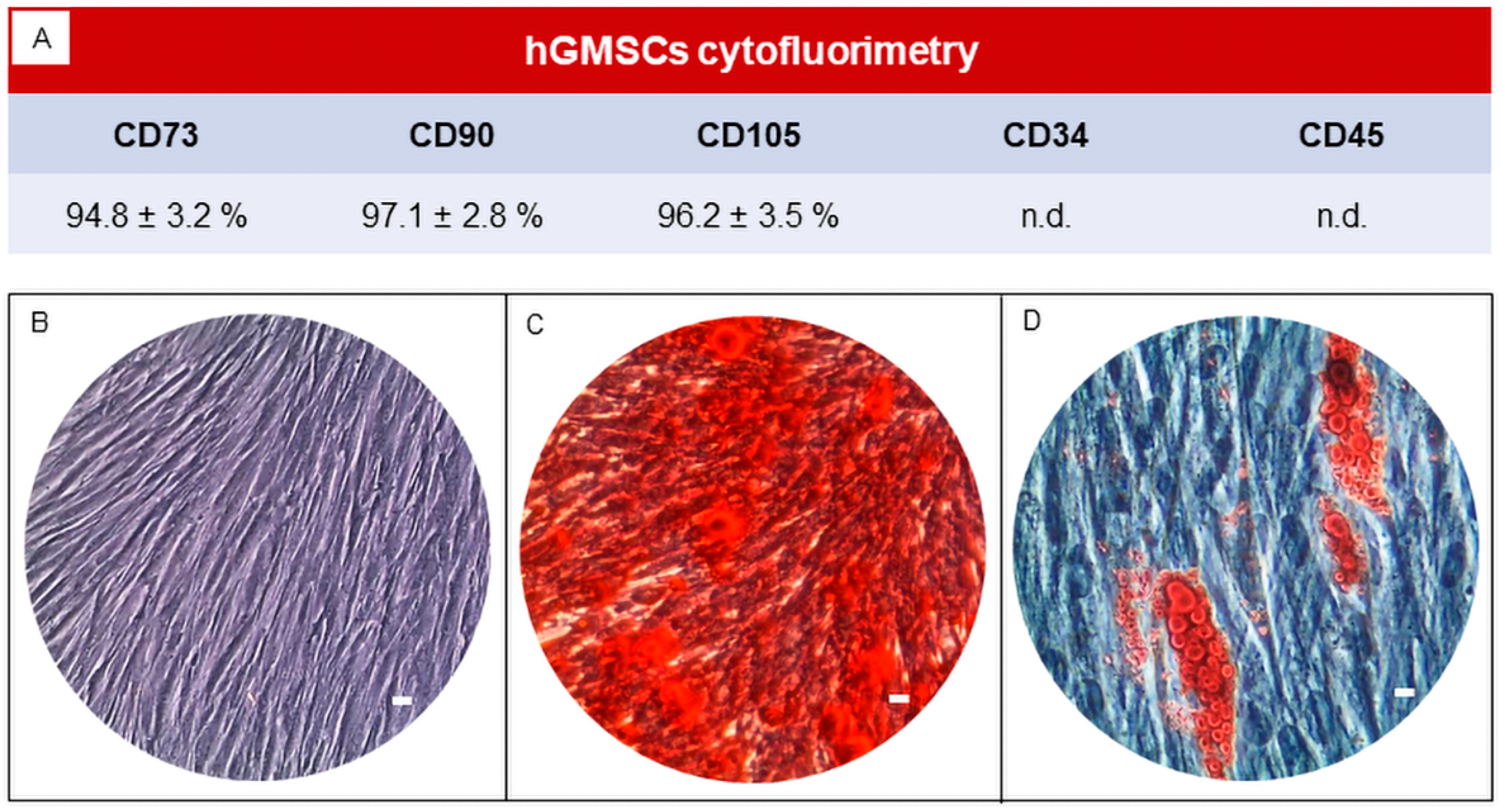
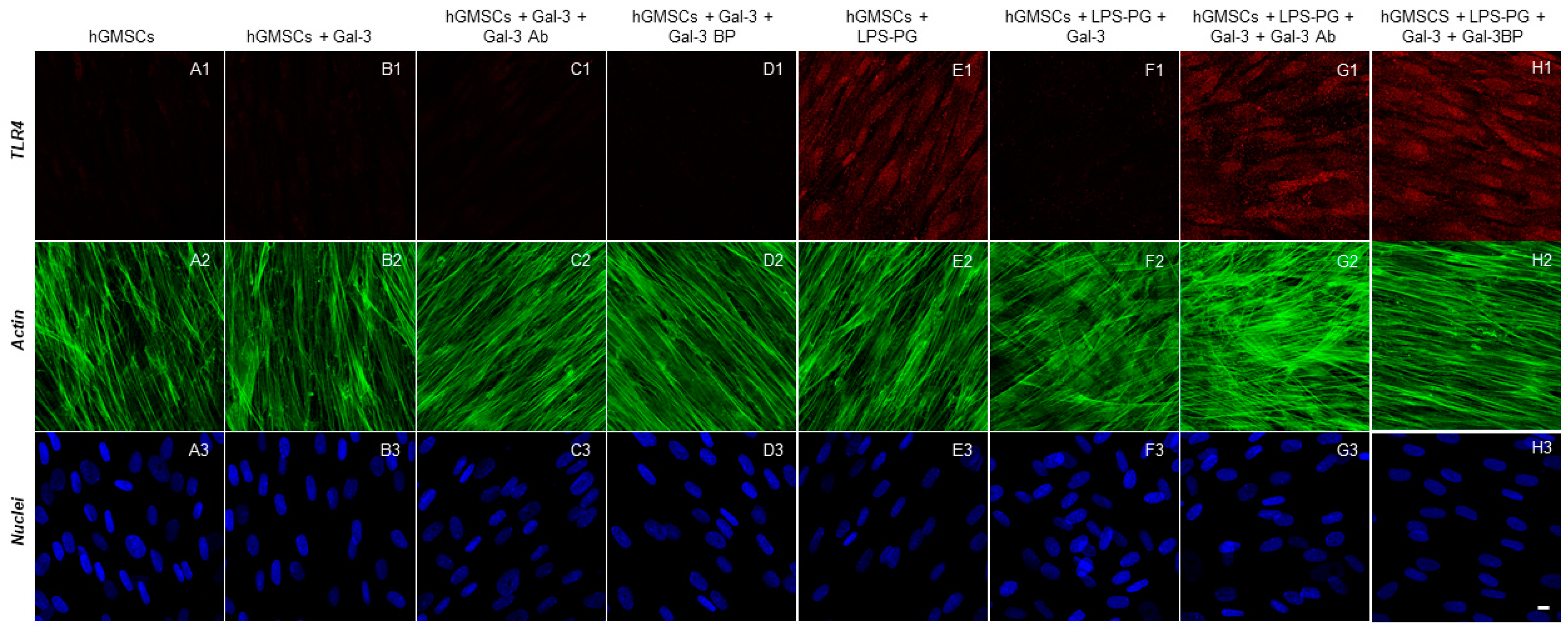
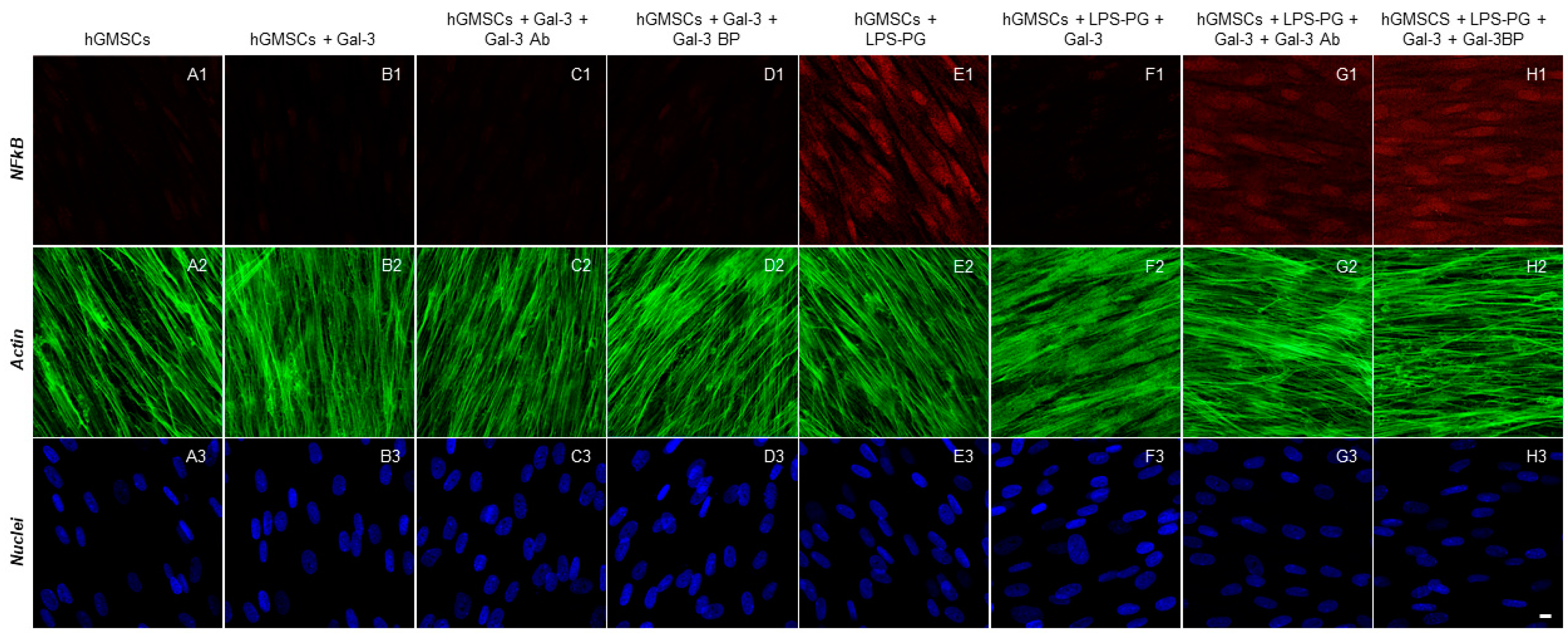
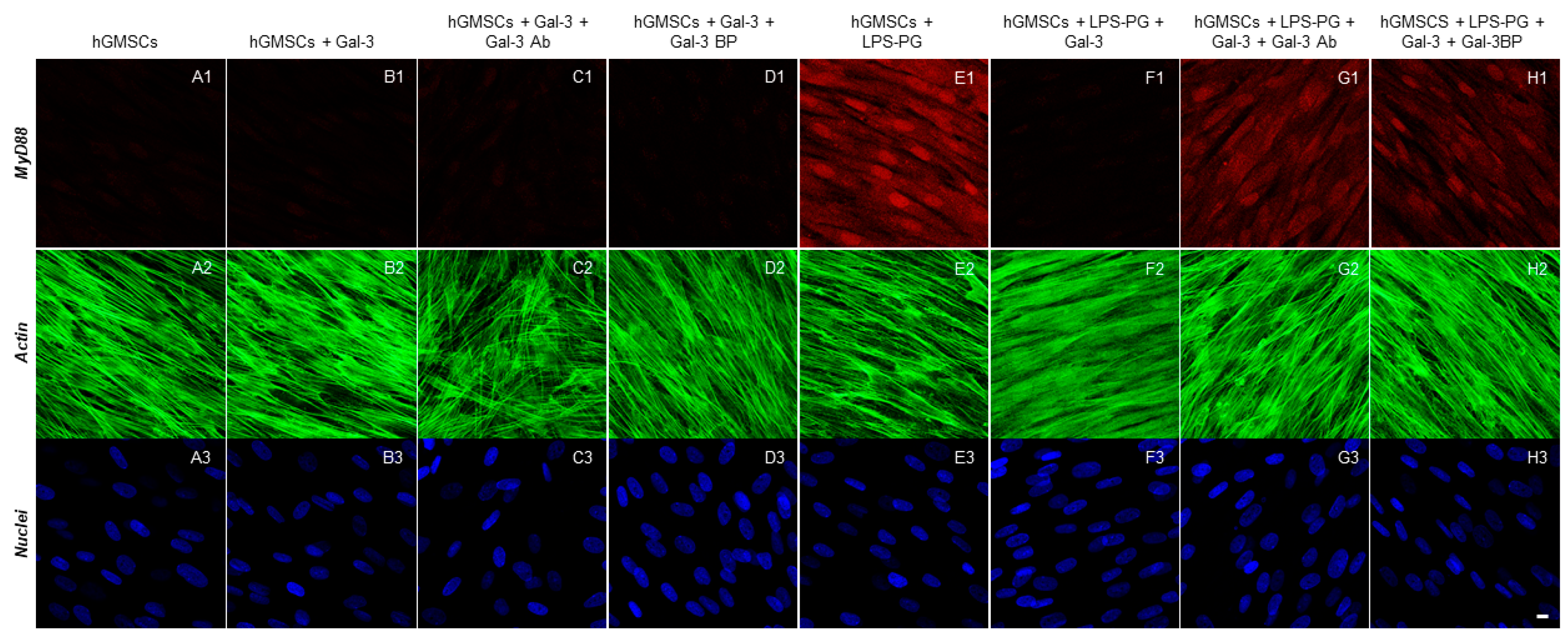
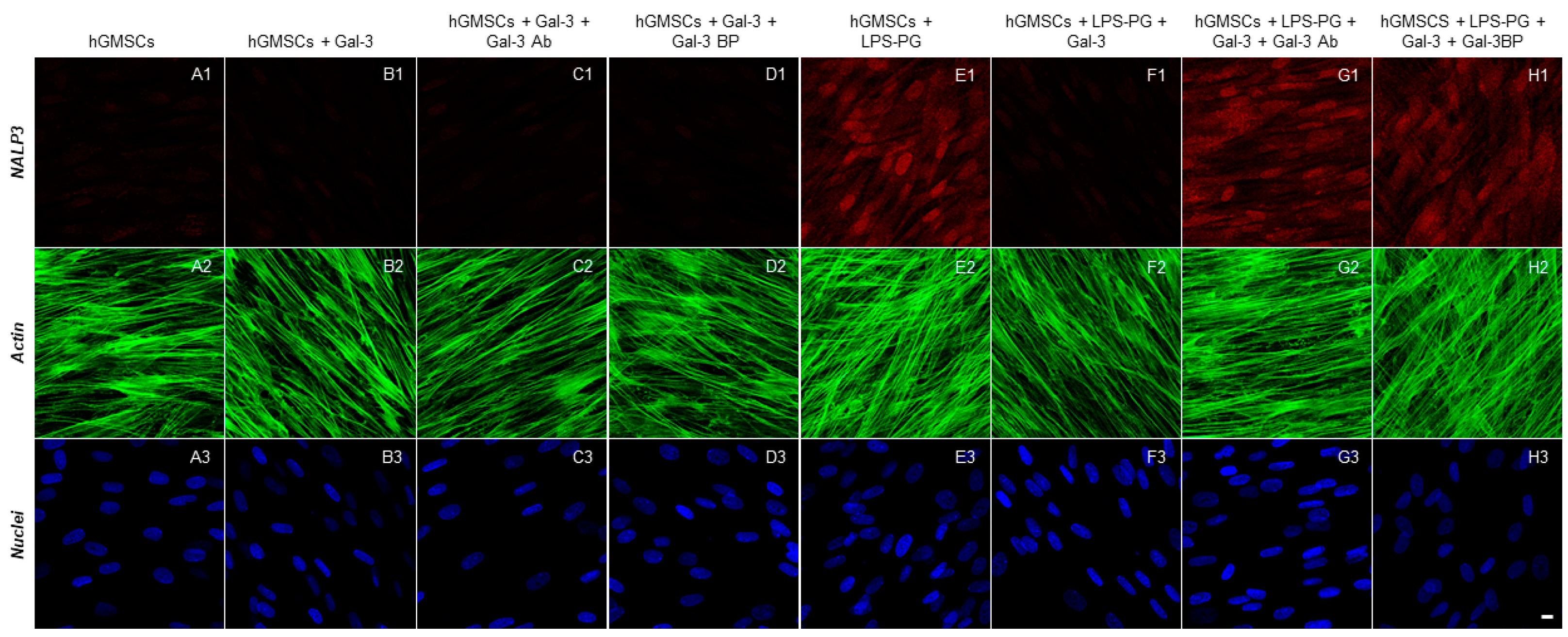
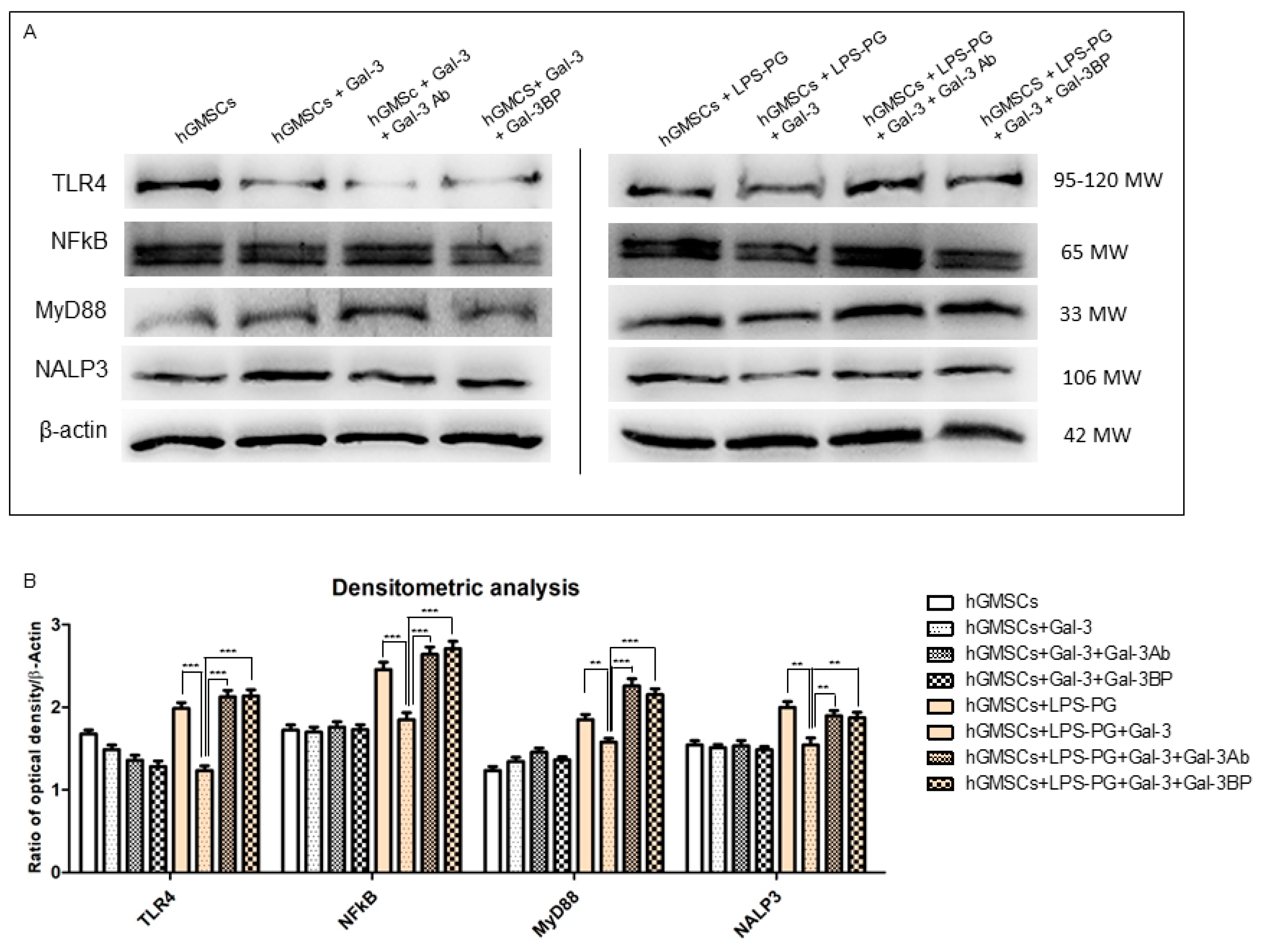
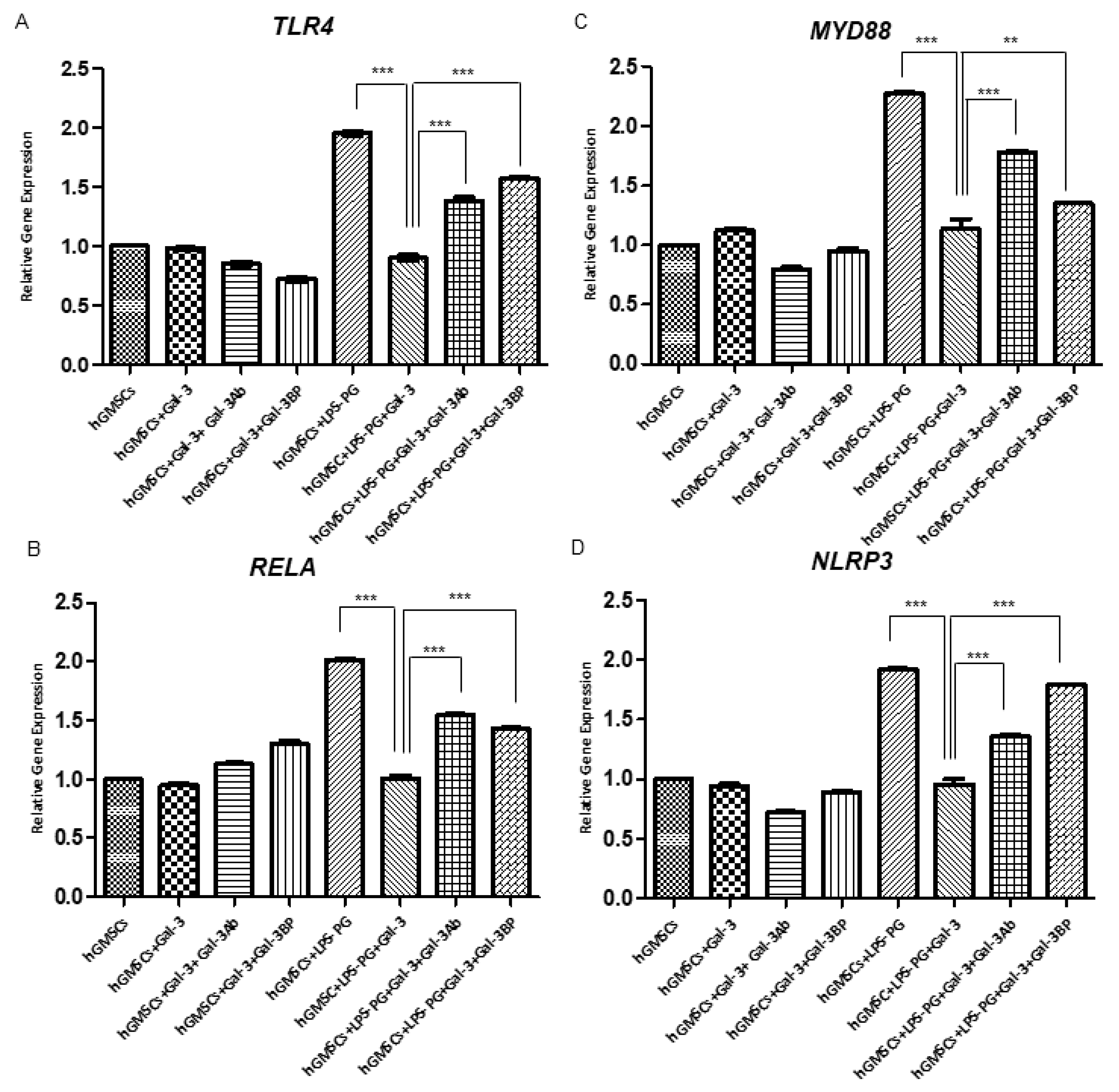
| Gene | Forward Primer Sequence (5′-3′) | Reverse Primer Sequence (5′-3′) |
|---|---|---|
| TLR4 | 5′-GAGTATACATTGCTGTTTCCTGTTG-3′ | 5′-ACCCCATTAAT- TCCAGACACA-3′ |
| MYD88 | 5′-CGGTCTCCTCCA- CATCCT-3′ | 5′-GCCGGACCCAA-GTACTCA-3′ |
| RELA | 5′-CGAGCTTGTAGGAAAGGACTG-3′ | 5′-TGACTGATAGC- CTGCTCCAG-3′ |
| NLRP3 | 5′-GAATGCCTTGG- GAGACTCAG-3′ | 5′-AGATTCTGATT- AGTGCTGAGTACC-3′ |
| B2M | 5′-GGACTGGTCTT-TCTATCTCTTGT-3′ | 5′-ACCTCCATGAT- GCTGCTTAC-3′ |
Disclaimer/Publisher’s Note: The statements, opinions and data contained in all publications are solely those of the individual author(s) and contributor(s) and not of MDPI and/or the editor(s). MDPI and/or the editor(s) disclaim responsibility for any injury to people or property resulting from any ideas, methods, instructions or products referred to in the content. |
© 2023 by the authors. Licensee MDPI, Basel, Switzerland. This article is an open access article distributed under the terms and conditions of the Creative Commons Attribution (CC BY) license (https://creativecommons.org/licenses/by/4.0/).
Share and Cite
Paganelli, A.; Diomede, F.; Marconi, G.D.; Pizzicannella, J.; Rajan, T.S.; Trubiani, O.; Paganelli, R. Inhibition of LPS-Induced Inflammatory Response of Oral Mesenchymal Stem Cells in the Presence of Galectin-3. Biomedicines 2023, 11, 1519. https://doi.org/10.3390/biomedicines11061519
Paganelli A, Diomede F, Marconi GD, Pizzicannella J, Rajan TS, Trubiani O, Paganelli R. Inhibition of LPS-Induced Inflammatory Response of Oral Mesenchymal Stem Cells in the Presence of Galectin-3. Biomedicines. 2023; 11(6):1519. https://doi.org/10.3390/biomedicines11061519
Chicago/Turabian StylePaganelli, Alessia, Francesca Diomede, Guya Diletta Marconi, Jacopo Pizzicannella, Thangavelu Soundara Rajan, Oriana Trubiani, and Roberto Paganelli. 2023. "Inhibition of LPS-Induced Inflammatory Response of Oral Mesenchymal Stem Cells in the Presence of Galectin-3" Biomedicines 11, no. 6: 1519. https://doi.org/10.3390/biomedicines11061519
APA StylePaganelli, A., Diomede, F., Marconi, G. D., Pizzicannella, J., Rajan, T. S., Trubiani, O., & Paganelli, R. (2023). Inhibition of LPS-Induced Inflammatory Response of Oral Mesenchymal Stem Cells in the Presence of Galectin-3. Biomedicines, 11(6), 1519. https://doi.org/10.3390/biomedicines11061519









